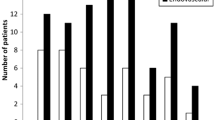Summary
Aneurysm surgery began in Lübeck only in 1986 when the department was completely reorganized. Early operation in the good grade patients (I–III, according to Hunt and Hess) was performed. In every case we also discussed the feasibility of operating on the poor grade patients (Hunt and Hess IV and V).
During a five-year period (1986–1991) a total of 277 SAH patients were admitted to the department. 109 (39%) patients arrived in a poor grade (Hunt and Hess IV or V), 12 of these patients died within hours of admission. 25 patients, who presented with a large intracerebral and/or subdural haematoma, were urgently operated upon by haematoma evacuation and aneurysm clipping. An external ventricular drainage was performed on 72 patients. Of the ventriculostomy group 33 patients improved and 27 were operated upon. In 17 of the 39 patients without improvement after CSF-drainage we decided to operate.
Overall 69 patients were surgically treated (craniotomy, aneurysm clipping) and 40 were not. The mortality rate in the surgical cases was 16 (23%) compared with 30 (75%) without operation.
It is concluded that poor grade aneurysm patients can achieve a better outcome with active treatment based on immediate ventriculostomy and optimal haemodynamic parameters after haematoma evacuation and early occlusion of the aneurysm.
Similar content being viewed by others
References
Adams HP Jr, Kassel NF, Tornar JC,et al (1981) Early management of aneurysmal subarachnoid haemorrhage. A report of the Co-operative Aneurysm Study. J Neurosurg 54: 141–145
Aoki N (1991) Rapid bedside technique for percutaneous ventricular drainage in patients with severe subarachnoid haemorrhage. Technical note. Acta Neurochir (Wien) 113: 184–185
Auer LM (1984) Acute operation and preventive nimodipine improve outcome in patients with ruptured cerebral aneurysms. Neurosurgery 15: 57–66
Auer LM, Brandt L, Ebeling U, Gilsbach J, Groeger U, Harders A, Ljunggren B, Oppel F, Reulen HJ, Säveland H (1986) Ni-modipine and early aneurysm operation for good condition SAH patients. Acta Neurochir (Wien) 82: 7–13
Bailes JE, Spetzler RF, Hadley MN, Baldwin HZ (1990) Management morbidity and mortality of poor-grade aneurysm patients. J Neurosurg 72: 559–566
Brandt L, Sonesson B, Ljunggren B,et al (1987) Ruptured middle cerebral artery aneurysm with intracerebral haemorrhage in younger patients appearing moribund: emergency operation? Neurosurgery 20: 925–929
Gilsbach JM, Harders AG, Eggert HR, Harnyak ME (1988) Early aneurysm surgery: a 7 year clinical practice report. Acta Neurochir (Wien) 90: 91–102
Gilsbach JM (1993) Surgery in poor grade SAH patients. Winter meeting, St Moritz. Personal communication
Hase U, Reulen HJ, Fenske A,et al (1978) Intracranial pressure and pressure volume relation in patients with subarachnoid haemorrhage (SAH). Acta Neurochir (Wien) 44: 69–80
Hunt WE, Hess RM (1968) Surgical risk as related to time of intervention in the repair of intracranial aneurysm. J Neurosurg 28: 14–19
Hunt WE, Kassell N, Pertuiset B, Sano K, Teasdale G, de Villier JC, Drake CG (1988) Report of the World Federation of Neurological Surgeons Committee on a universal subarachnoid haemorrhage grading scale. J Neurosurg 68: 985–986
Jennett B, Bond M (1975) Assessment of outcome after severe brain damage. Lancet i: 480–484
Kassell NF, Peerless SJ, Durward WS,et al (1982) Treatment of ischaemic deficits from vasospasm with intravascular volume expansion and induced arterial hypertension. Neurosurgery 11: 337–343
Ljunggren B, Säveland H, Brandt L, Zygmunt S (1985) Early operation and overall outcome in aneurysmal subarachnoid haemorrhage. J Neurosurg 62: 547–551
Ljunggren B, Brandt L, Säveland H,et al (1987) Management of ruptured intracranial aneurysm: a review. Br Neurosurg 1: 9–32
Nornes H (1973) The role of intracranial pressure in the arrest of haemorrhage in patients with ruptured intracranial aneurysm. J Neurosurg 39: 226–234
Petruk KC, West M, Morh G,et al (1988) Nimodipine treatment in poor-grade aneurysm patients. Results of a multicenter double-blind placebo-controlled trial. J Neurosurg 68: 505–517
Säveland H, Sonesson B, Ljunggren B,et al (1986) Outcome evaluation following subarachnoid haemorrhage. J Neurosurg 64: 191–196
Seiler RW, Reulen HJ, Huber P, Grolimund P, Ebeling U, Steiger HJ (1988) Outcome of aneurysmal subarachnoid haemorrhage in a hospital population: a prospective study including early operation, intravenous nimodipine, and transcranial Doppler ultrasound. Neurosurgery 23: 598–604
Seifert V, Trost HA, Stolke D (1990) Management morbidity and mortality in grade IV and V patients with aneurysmal subarachnoid haemorrhage. Acta Neurochir (Wien) 103: 5–10
Sundbärg G, Pontén U (1976) ICP and CSF absorption impairment after subarachnoid haemorrhage. In: Beks JW, Bosch DA, Brock M (eds) Intracranial pressure III. Springer, Berlin Heidelberg New York, pp 139–146
Sundt TM Jr, Kobayashi S, Fode NC,et al (1982) Results and complications of surgical management of 809 intracranial aneurysms in 722 cases. Related and unrelated to grade of patient, type of aneurysm, and timing of surgery. J Neurosurg 56: 753–765
Yasargil MG, Yonekawa Y, Zumstein B,et al (1973) Hydrocephalus following spontaneous subarachnoid haemorrhage. Clinical features and treatment. J Neurosurg 39: 447–479
Author information
Authors and Affiliations
Additional information
Dedicated to Prof. Dr. H.-D. Herrmann on the occasion of his 60th birthday.
Rights and permissions
About this article
Cite this article
Nowak, G., Schwachenwald, R. & Arnold, H. Early management in poor grade aneurysm patients. Acta neurochir 126, 33–37 (1994). https://doi.org/10.1007/BF01476491
Issue Date:
DOI: https://doi.org/10.1007/BF01476491



